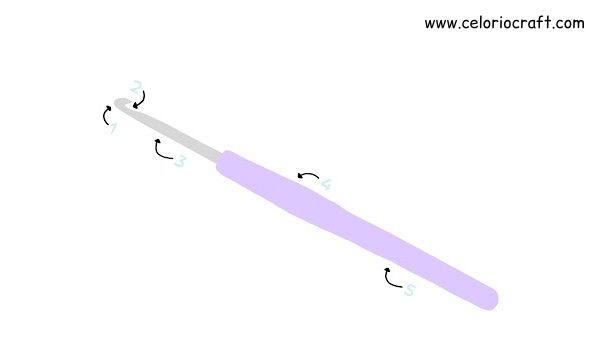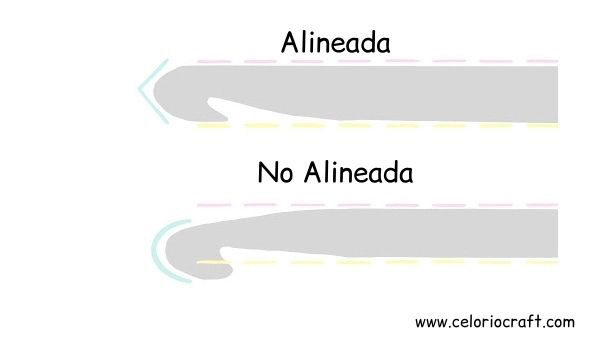I’m sure you’re wondering what is this inline and tapered hook thing, I promise you it’s an interesting topic that you’ll like to know a little bit about.
You may already know that the crochet hook has different parts and shapes and according to this they are classified as Inline or Tapered.

What is the Point of the Crochet Hook?
The point (part 1 in the photo above) of the crochet hook is the part we use to grab the yarn and make the loop. This is also the part that goes inside the stitches to pull the yarn through them.
If you examine your hooks in more detail, you will see that they can have the point in two different ways. And also, the shape of the hook and the throat of the needle (part 2 in the photo above) varies from one hook to another. Taking all this into account, we can classify them into two types of hooks:
Inline: In this type of crochet hooks, the point is aligned with the rest of the hook. They also tend to have a more pointed tip and a deeper neck.
Tapered: In this type of hooks the point is not aligned with the rest of the hook, it is a little inclined. In this case the point is usually more rounded and the throat of the hook is not as deep as in the inline hook.
Crochet Hook Types
Although there are some differences between them, it is true that it does not influence the final result very much. In other words, your finished project will look the same if you make it with an Inline hook or with a tapered hook. Their differences have more to do with the process and the comfort of the crocheter.
Benefits of using an Inline Hook

Benefits of using a Tapered Hook
- According to some crocheters it can help you work faster.
- It is very useful for working with yarns that easily split. As it has a rounded tip, it does not unravel fibers so easily.
- According to many crocheters, by using this type of hook you can avoid the pain in your wrist. This is due to the fact that since the throat of the hook is less deep, you have to make a shallower turn when making stitches, unlike the Inline needle which, having a deeper throat, requires you to make a greater turn with your wrist to make each stitch.
All these pros and cons are very subjective, which in other words, maybe for other crocheters it works this way and for you it works differently.
What I can assure you is that it is much easier to work with slip stitches if you use an Inline hook.
It is also true that with time and experience we use the type that we prefer without knowing sometimes why.
What they are called in Spanish and why you should know it
In Spanish, it is referred to as follows:
Alineada: inline
No Alineada: tapered
And you may wonder why you should know how the hooks are called in Spanish. It’s very simple, if you are learning to crochet patterns in Spanish it is very useful to know this information. It may be the case that in a certain pattern you are advised to use an inline needle, for example, to make the ribbing, since they are made in slip stitches, and it is much easier that way.
In Spanish patterns, you will find this term mainly in the section of tips or advice they give you to get a better result. You might also find it in the materials section when they refer to the hooks you will need.
Now you know it for when you are crocheting in Spanish and you find these terms that I have taught you.
I hope you have found this information useful and that you can now decide which hook is best for you on each occasion, because you don’t always have to use the same type.
Are you on Instagram, if so find me there!
Have a good crochet time!
